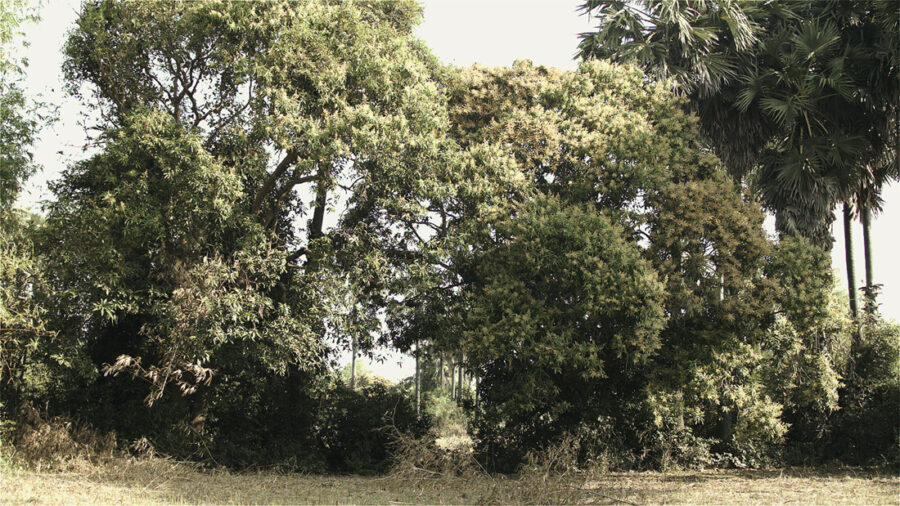
Coproduction : Jeu de Paume, Paris, Fondation Nationale des Arts Graphiques et Plastiques et CAPC musée d'art contemporain de Bordeaux.
Courtesy de l’artiste © Vandy Rattana, 2015
Exhibition
Vandy Rattana. MONOLOGUE
Programmation Satellite 8
From 24 February to 17 May 2015
Jeu de Paume – Paris
To watch the video portrait:
The practice and works of Vandy Rattana serve to contradict the images of Cambodia that have been most widely captured and circulated. From the early ethnographic gaze during the French
Protectorate to recent decades of war reportage, genocide studies, and cliché’s of tourism, a disproportionate engagement with Angkor Wat and the Khmer Rouge perpetuates a static imaginary of
a place and people incapable of continuity.
Born into the tenuous recovery period after the official fall of the Khmer Rouge, Vandy Rattana began photographing as a form of continuity, concerned with the lack of physical documentation of more personal stories, traits and monuments unique to his history and culture. His early serial works straddled the line between strict photojournalism and conceptual practice, and all displayed a preoccupation with the everyday as experienced by the average Cambodian.
With subjects ranging from casual domestic situations involving Vandy’s family to labor conditions on today’s rubber plantations and the building of the capital’s first skyscraper, Vandy’s early series chronicled the contemporary moment while creating a more comprehensive archive for future generations.
Vandy’s most acclaimed work, Bomb Ponds, was made following a transformative encounter with the craters left over from the United States’ bombing of Cambodia during the Vietnam War.
Dissatisfied with the level of documentation on the bombing and its repercussions, the artist turned toward intensive study and scrutiny of the historiography of his country. He traveled to the ten
most severely bombed provinces, engaging villagers in locating and testifying to the existence of the
craters, and how they are lived with today.
MONOLOGUE offers another portrait of the land, another physical and physiological scar, another silenced aftermath that is given voice.
The only sound in the film —the artist’s monologue— is directed at the sister he never met, who rests
somewhere beneath a small, measured plot of land, alongside his grandmother, and five thousand
others who were discarded during the Khmer Rouge regime in 1978. Unlike at the tourist site known as
the Killing Fields, one does not pay to enter this grave.
There is no signage, no skulls on view, no annual reenactment of killing for spectators. Vandy’s
sister’s grave resembles thousands of others around the country as they are today: unmarked, fertile,
agricultural land. The film approaches the site by overlapping these past and present histories.
Vandy’s monologue addresses the sister and her absences —a relationship between them that
never was, the unknown location of her bones beneath the ground, her unidentified soul, her
unknown characteristics based on the one photograph that remains of her, which we never see.
His tone oscillates between calm and hysteria. Before surveying the parched, dry season ricepaddy
grave, Vandy establishes two noble mango trees as witnesses.
We learn how, saplings in 1978, these trees were fertilized by the thousands of dead, growing large to
form a rich habitat for birds and a rare shade for farmers.
We learn of the taste of their fruits and perfect paring with fish, the smell of their flowers.
Just as these details begin to confusingly assuage a palpable trauma, a trio of farmers imitates a rice planting and harvest as the monologue meditates on the farmers’ daily life, and on the absurdity and inevitability of violence and obscurantism.
MONOLOGUE turns silent as the artist enters the image to gather souvenirs from the earth and trees, which we learn were offered to his parents to vague reception.
The artist’s dramatic voice and the dream-like sequences in MONOLOGUE counter that of
the journalist, that of the official Khmer Rouge trial testimonies.
When violence can no longer be seen, Vandy complicates our perception of its aftermath with intimacy. What is reconciliation? Is continuity memorial enough?
MONOLOGUE destabilizes time, the distance of history, bipolar ideas of justice, the possibility
of logic, and of peace.
It becomes difficult to continue gazing at this history as if it belongs to others.
Curator: Erin Gleeson.
Partners: The exhibition is co-produced by the Jeu de Paume,
the Fondation Nationale des Arts Graphiques et Plastiques (FNAGP),
and the CAPC musée d’art contemporain de Bordeaux.
The Friends of CAPC
contribute to the production of works in the Satellite program.
Media Partners:
Art press, ParisArt, Slash-paris.com, Souvenirs from earth TV, Radio Nova, L’oeil, Le Journal des Arts.
